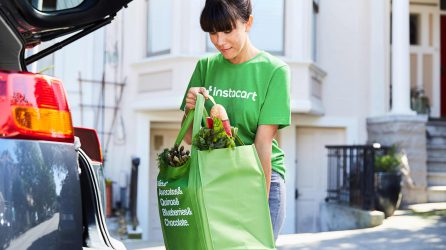How FMCG brands can get HFSS-ready on the digital shelf

Presented by:
Vanessa Thompson — 2022
This post has been updated and was originally published May 4, 2022.
The UK grocery retail market is about to experience one of the biggest shakeups in decades.
To curb obesity rates, the government is introducing far-reaching restrictions on products classed as high in fat, sugar or salt (HFSS) in England. Volume-based promotions such as ‘buy one get one free’ and ‘3 for £10’ will be outlawed for these products, and HFSS items will be banned from key locations such as store entrances, gondola ends, and checkouts. A separate clampdown on advertising and digital marketing for unhealthy food and drink has also been announced.
The new rules will apply in-store as well as online, but retailers and brands have so far focused largely on the in-store environment in their HFSS preparations. This is entirely understandable given the space constraints there.
But HFSS will also have significant ramifications for online grocery. The location-based restrictions on HFSS products will affect everything from banner ad placements to sponsored search, pop-ups, and promotions at checkout. Meanwhile, reformulation efforts will create mountains of new product data that needs to be updated, optimized, and monitored for compliance.
Despite expected delays to the ban on 'multi-buy deals, implementation for location-based restrictions is only a few months away. Yet, key aspects of the new rules remain unclear and many brands say they are confused about what they will and won’t be allowed to do. Recent research suggests half of UK food and drink brands feel unprepared for the new regulations.
Still, there’s a lot brands can do to get ready for HFSS on the digital shelf – even while some grey areas remain. Here’s what to focus on in the coming months.
What to do in the run up to HFSS
As it stands, the restrictions on HFSS promotions, that is location-based restrictions, will likely come into force on 1 October 2022. Lobbying efforts to delay this are ongoing, but brands should not assume further delays are inevitable. Although the cost-of-living crisis and conflict in Ukraine have created compelling new arguments for pushing back the date, the fact that the UK government published implementation guidance for HFSS in early April is seen as a sign that it’s minded to go ahead as planned, if even partly.
This means the only rational approach right now is to get ready for October. A surprising number of FMCG brands still have their heads in the sand and lack any sense of urgency around HFSS. But time is ticking. To stand any chance of being HFSS-compliant by the time the new regulations take effect, brands must act now.
From a digital shelf perspective, the focus in the run up to October should be on establishing the level of exposure for your brand, your products, and your category.
Reformulation is, of course, a priority for FMCG suppliers; many are also looking at pack sizes and assessing to what extent their promotions will be at risk. But getting ready for HFSS is not just about understanding what you need to do to be compliant. It’s also about understanding what the wider market will be doing.
We find this to be a common blind spot in brands’ preparations for HFSS. Many suppliers, especially smaller ones, are too focused on themselves and not paying enough attention to what will be happening in the wider market or category.
Digital shelf analytics can help you look at all the promotions that were run in a category over a period of time, so you can work out what percentage of promotions are at risk for you as well as your competitors. This will help you see what the space could look like post-HFSS and put you in the best position to start having strategic conversations with retailers.
Brands should also be alive to potential challenges around digital taxonomy. Do your products currently sit under categories that retailers may look to relabel or reconfigure to comply with location-based restrictions on HFSS products? Think ‘healthier bars’ in the cereal bars category, for example.
The HFSS restrictions will almost certainly bring changes to the digital shelf in terms of where you can place your SKUs. Smart brands will be looking to anticipate those to get ahead of the curve.
What to do once HFSS restrictions are in force
Once the new restrictions are live, it’s all about tracking.
If brands have reformulated and/or changed pack size, they need to ensure those changes have been implemented correctly online. Are gold-standard images, titles, and descriptions being used? How about new packaging and new nutritional information – have they been implemented as requested ? And is the new information optimized to ensure the best possible performance in search? With hundreds of products being updated across multiple categories, it will be easy for something to go awry, so brands need a systematic approach to monitoring compliance.
Tracking ratings and reviews will also be essential. Product reformulation and pack size changes can be divisive, so brands should carefully monitor shopper feedback to pick up on potential problems early. They should also track how other brands’ reformulations go down with consumers. With our ‘Learn from the Shopper’s Voice’ feature, brands can spot reformulated products that are underperforming based on customer ratings and use this information to their advantage in range reviews.
As the HFSS clampdown will limit where brands can place banner ads on online grocery sites, banner tracking capability is another key feature to have in your digital shelf analytics armory. Brands will need to ensure their own banners are HFSS-compliant and being placed in the right areas, and they’ll need to understand what their competitors are doing. Where are they placing their banners post-HFSS to maximize click-through rates?
More generally, what is the competition investing in once multibuy deals are no longer allowed? A huge chunk of money goes into these promotions every year, so lots of trade spend will be redirected elsewhere. Post-HFSS, investment in banner ads or sponsored search could increase significantly in your category and affect your ability to be seen by shoppers. Close tracking of competitor activity will help you spot patterns early and respond.
Ideally, you want to track not just what campaigns are being run at a category level, but also compare retailer to retailer. Our clients do this through our ‘Winning Campaigns’ feature. In the absence of clearer guidance, retailers will have to do most of the work on interpreting the new HFSS rules themselves – and those interpretations could vary significantly.
Again, tracking will help you see the full picture and put you in the best position to identify opportunities while minimizing tactical risk.
Finally, there’s shopper behavior. The impact of HFSS restrictions on consumer choices is hard to gauge at this stage, but brands will want to closely monitor changes to search patterns and track how different promotional mechanics affect their search rankings. For every 1% incremental change in search ranking brands see on average a 4% increase in incremental sales, so it’s essential to track how different promotional strategies interact with search.
There is no doubt: the changes brought by the new restrictions will be seismic. To manage the uncertainty and win in the post-HFSS world, grocery brands need to get on the front foot now, make sure they have solid digital shelf analytics data for ‘test and learn’ scenarios – and keep a very keen eye on what everyone else is doing.
All the digital Shelf Analytics You Need to Succeed at Speed & Scale
See why world leading brands choose e.fundamentals for actionable digital shelf insights
Request A demoLatest Resources

CommerceIQ Launches Global Retail Ecommerce Management Platform Combining Sales, Supply Chain, Retail Media, and Digital Shelf with e.fundamentals Acquisition
Ecommerce platform enables consumer brands to grow market share profitably in today’s inflationary and supply-constrained environment through intelligent automation, supporting over 450 omnichannel retailers in 41 countries.

e.fundamentals becomes a CommerceIQ company
e.fundamentals has been acquired by CommerceIQ, the leading Retail Ecommerce Management Platform, headquartered in Palo Alto, California. Consumer brands can now harness one global software platform to power profitable market share growth across all major retailers.

5 strategic pricing opportunities CPGs should focus on now
As tensions run high between retailers and suppliers, CPGs need to be smarter than ever about strategic pricing. Here’s how to use digital shelf analytics to hold your own in tough negotiations.

What the smartest CPGs get right about selling on Instacart
This post has been updated and was originally published March 30, 2021. It's time CPGs get ready to win on Instacart. So read and learn: What's all the hype around…

5 optimization tactics to grow digital shelf sales
This post has been updated and was originally published May 14, 2020. Consumer goods companies (CPG) continue to grapple with enormous shifts to the industry as the eCommerce boom continues…

5 tactics to grow online sales for category managers
Category management has changed. We've highlighted the 5 tactics to help you scale your growth on the digital shelf at speed.
View Our Most Popular resources to help you learn and win on the digital shelf.

The Ultimate Guide to Content Management on the Digital Shelf

The Digital Shelf Cast - Listen to our latest episode





